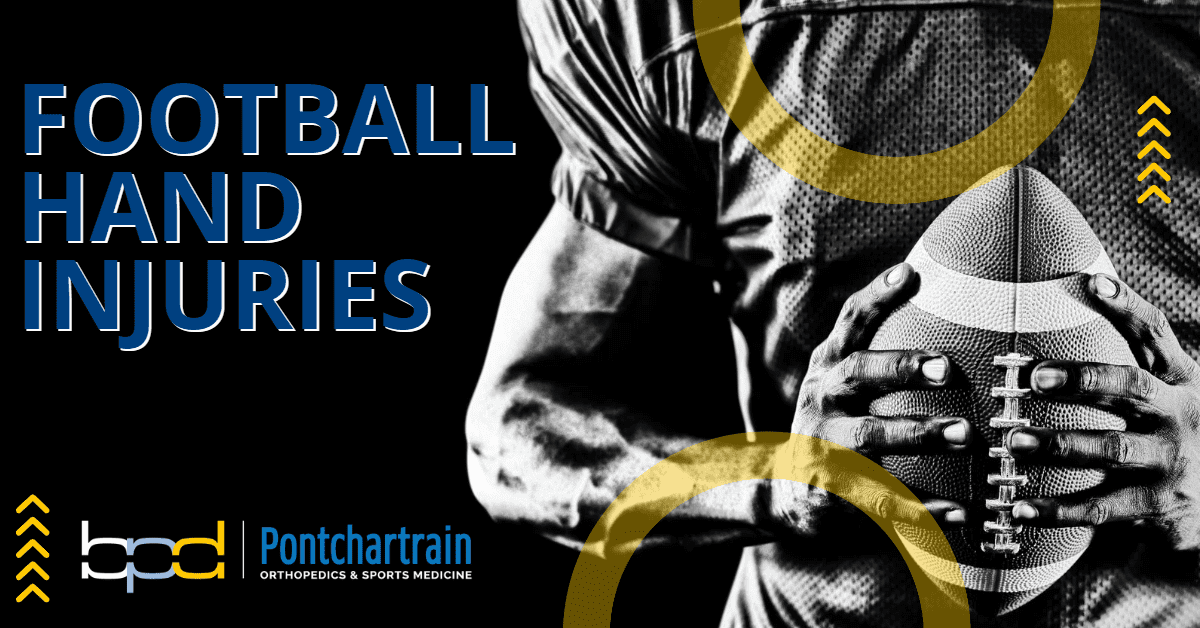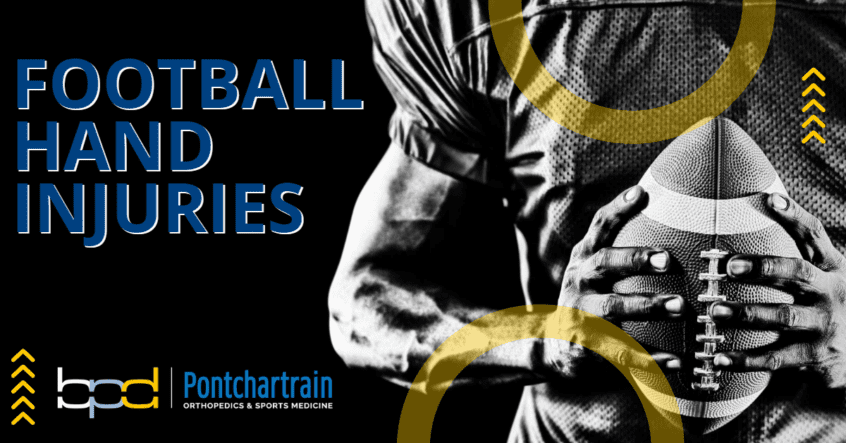
It’s football season again! As a football fan, sideline physician, and orthopedic hand specialist, Dr. Brandon P. Donnelly is particularly well-versed in the hand and wrist injuries that can occur during practice and games. These injuries can range from minor annoyances to more severe cases requiring extended recovery or even surgery.
In today’s post, Dr. Donnelly will explain the most common football-related hand and wrist injuries, offering guidance on how to recognize and treat them, ensuring a safe return to the game.
Jammed Finger
A jammed finger is a common football injury that occurs when the finger is forcefully compressed, usually resulting in a sprain or damage to the ligaments. This type of injury typically causes pain, swelling, and limited range of motion but doesn’t involve any bone damage. The best treatment for a jammed finger is the RICE method—Rest, Ice, Compression, and Elevation. Taping the injured finger to a neighboring healthy finger, known as “buddy taping,” can also help stabilize the joint and encourage proper healing.
Dislocated Finger
A dislocated finger is a more severe form of a jammed finger, often resulting from a direct blow, twisting, or landing injury. In a finger dislocation, the ligaments surrounding a finger joint are torn, and the two bones that make up the joint are no longer in proper alignment. Symptoms include pain, obvious deformity, and inability to move the affected joint. Treatment requires prompt repositioning of the bones, which should only be performed by a medical professional. After repositioning, the finger will need a period of immobilization. In some cases, surgery may be required to ensure the proper healing of the joint and surrounding ligaments.
Thumb Sprain
A thumb sprain involves the stretching or tearing of a small ligament at the base of the thumb, often caused when the thumb is forcibly pressed away from the rest of the hand. Symptoms include pain and swelling along the base of the thumb, along with difficulty gripping objects. Treatment for a thumb sprain varies depending on the severity and can include ice, anti-inflammatories, thumb spica bracing, and in more severe cases, surgery. Before returning to the game, it’s important to seek advice from your trainer or orthopedic surgeon to ensure proper healing and prevent further injury.
Broken Finger
A broken finger, on the other hand, involves a fracture in one of the finger bones, often accompanied by more severe symptoms such as significant swelling, misalignment, or even dislocation. Unlike a jammed finger, a broken finger usually requires medical attention to ensure proper healing and avoid complications. An X-ray is necessary to assess the extent of the injury. Treatment for a broken finger can range from immobilization with buddy taping to more invasive options like surgery, depending on the severity and type of fracture. Surgery may involve pinning the bones with wires or using plates and screws to realign and stabilize the bones. In cases where ligaments are also torn, surgical repair followed by a period of immobilization may be necessary to restore full function and prevent long-term issues.
Mallet Finger
Mallet finger is a tendon injury that prevents the active straightening of the fingertip, often occurring when a ball or object strikes the tip of the finger. Symptoms include pain and swelling at the fingertip, along with the inability to actively hold the finger straight, though passive straightening is possible. Treatment typically involves immobilization in a specialized splint to allow the tendon to heal. In some cases, surgery may be required. It's important to discuss your return-to-play plan with an orthopedic specialist to ensure proper recovery.
Jersey Finger
Jersey finger is a tendon rupture that prevents the active bending of the fingertip, usually occurring when trying to grip an opposing player’s jersey, only to have the other player break away forcefully. This results in the finger being forcefully extended while the tendons are attempting to hold the finger flexed, causing the tendon to rupture. Symptoms include pain, swelling along the fingertip, and the inability to actively flex the finger. Jersey finger requires prompt surgical intervention, and an appointment with an orthopedic hand surgeon should be made as soon as possible.
Boxer’s Fracture
A boxer’s fracture involves a fracture in one of the bones in the palm of the hand, typically occurring when a clenched fist strikes a helmet or another object. Symptoms include pain and swelling along the back of the hand. Treatment often involves ice, anti-inflammatories, and immobilization in a cast. In some cases, surgery may be necessary to realign the bones before casting to ensure proper healing.
Scaphoid Fracture
The scaphoid is one of the small carpal bones in the wrist and is a common injury in football, often resulting from concussive force to the wrist during falls or blocking. Symptoms include pain, swelling in the wrist, and point tenderness just below the base of the thumb. The scaphoid fracture is known for its slow healing process. Treatment options depend on the type of fracture and may involve immobilization in a cast or surgery to facilitate proper healing.
Have Questions About a Football Hand Injury?
About Dr. Brandon P. Donnelly, MD
 Dr. Brandon P. Donnelly is a board certified hand surgeon with Pontchartrain Orthopedics & Sports Medicine. Dr. Donnelly completed his hand and microsurgery fellowship at the prestigious Philadelphia Hand to Shoulder Center. Dr. Donnelly treats all ages of patients in the greater New Orleans area for hand, wrist, and elbow conditions.
Dr. Brandon P. Donnelly is a board certified hand surgeon with Pontchartrain Orthopedics & Sports Medicine. Dr. Donnelly completed his hand and microsurgery fellowship at the prestigious Philadelphia Hand to Shoulder Center. Dr. Donnelly treats all ages of patients in the greater New Orleans area for hand, wrist, and elbow conditions. 
